WRRC Analytical Laboratory Instruments
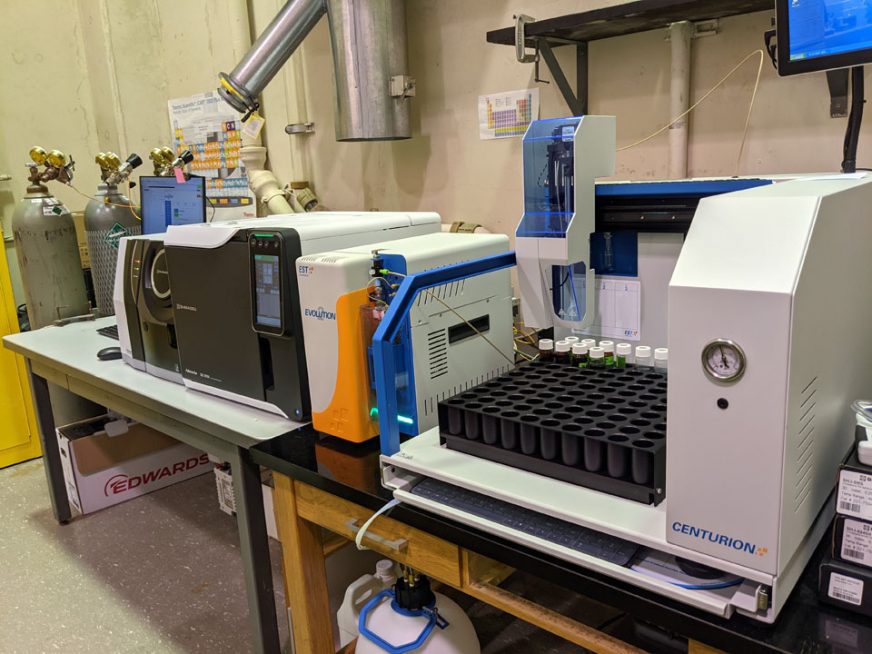
(Temporarily Unavailable) Shimadzu Nexis GC-2030 and TQ8050 NX GC/MS/MS, EST Centurion and Evolution 2:
The gas chromatograph is equipped with an automated purge and trap concentrator (EST Centurion and Evolution 2) that allows for the measurement of volatile organic compounds in water. The detector for this system is a triple quadrupole mass spectrometer, also known as tandem MS, or MS/MS. These three quadrupoles allow two mass spectrometers to be coupled, which makes this system capable of ultra-trace level quantitative analysis, down to femtogram levels. The MS/MS also allows for the investigation of molecular structure by fragmentation patterns.
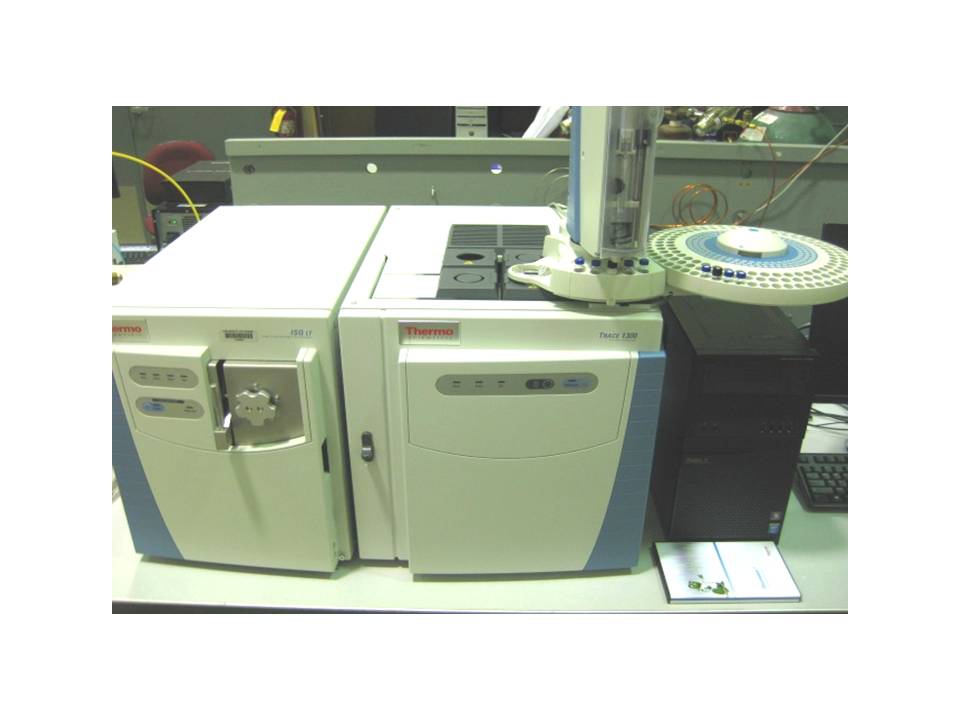
Thermo Scientific GC/MS and Tekmar Atomx XYZ:
This is a Trace 1300 model Gas Chromatograph (GC) with an ISQ_LT Mass Spectrometer (MS) and an automated purge and trap concentrator. In addition to the usual retention time data, GC/MS provides compound-specific information via the unique fragmentation pattern of the compound being analyzed. This pattern can be compared to a database of over 100,000 compounds for positive identification of the analytes. It also has Flame Ionization (FID), Electron Capture (ECD), and Thermal Conductivity (TCD) detector modules for maximum analytical flexibility. Using the FID, it can analyze any compound that has a C-H bond. The FID is the generic, default detector in the GC world. It’s most often used for detecting petroleum hydrocarbons like gasoline, diesel, jet fuels, etc. The ECD is a more sensitive detector for halogenated compounds. It does well with detecting chlorinated pesticides and PCBs. Volatile halogenated compounds like freons and chlorinated industrial solvents can also be detected. The TCD is used for the analysis of permanent gases, such as methane and carbon dioxide levels in biogas. Data from this instrument is collected by Chromeleon software which can process the data, compare it to calibration curves, and prepare spreadsheets of the results automatically.
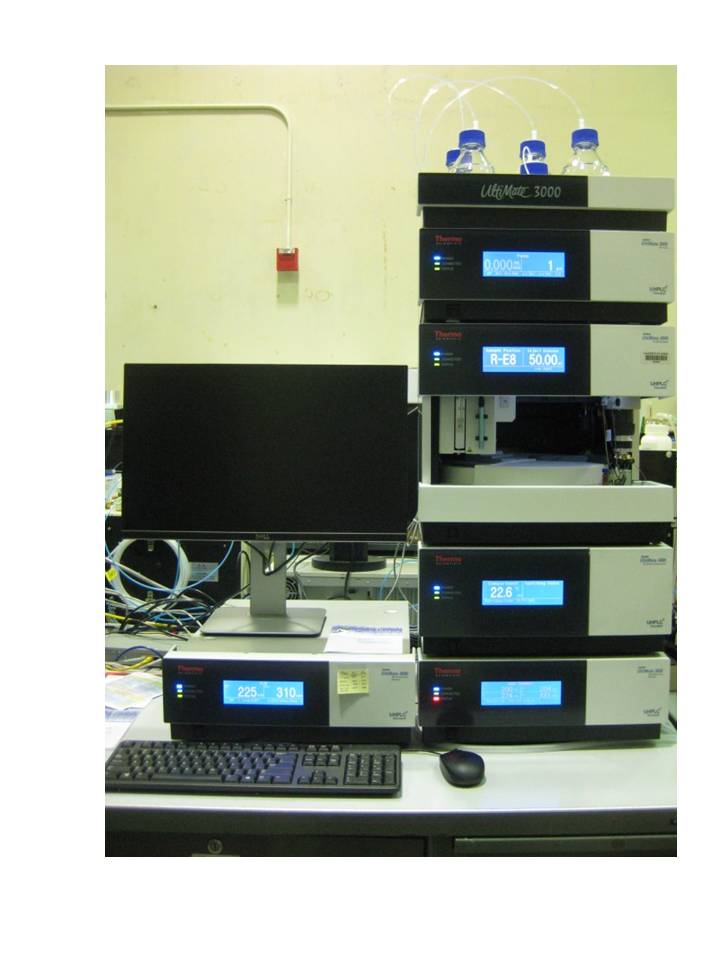
(Temporarily Unavailable) Thermo Scientific UHPLC:
This is an UltiMate 3000 Ultra High-Pressure Liquid Chromatograph (UHPLC) equipped with a Fluorescence Detector (FLD) and a Diode Array Detector (DAD) capable of monitoring 4 different wavelengths simultaneously. The DAD is used for the analysis of ultraviolet absorbing compounds, typically compounds that contain unsaturated bonds or aromatic groups. The FLD is a more sensitive detector used for compounds which can fluoresce, like polynuclear aromatic hydrocarbons (PAHs), estrogens and alkylphenols.
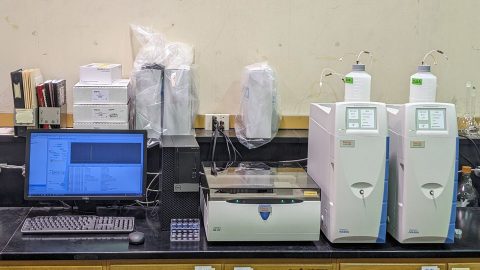
Dionex Aquion:
For the analysis of common inorganic anions and cations, WRCC uses two Dionex Aquion ion chromatography systems with an AS-DV autosampler. The ions are first separated then detected by conductivity. It is capable of simultaneously measuring fluoride (F–), chloride (Cl–), nitrate (NO3–), phosphate (PO42-), sulfate (SO42-), sodium (Na+), potassium (K+), ammonium (NH4+), calcium (Ca2+), and magnesium (Mg2+) in various types of water samples.
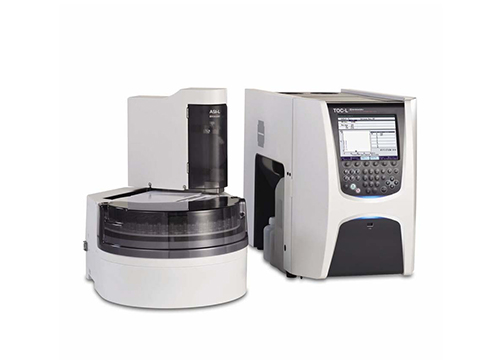
Shimadzu TOC-L Total Organic Carbon (TOC) Analyzer with a Total Nitrogen (TN) Detector:
This instrument will analyze liquid samples for Total Carbon (TC), Inorganic Carbon (IC), and Total Organic Carbon by difference. It can also analyze non-purgeable organic carbon (NPOC). It's capable of measuring Total Nitrogen (TN) concurrently with TOC analysis. It also has an autosampler, computer data acquisition, instrument control software and the 5000A SSM attachment for solid sample analysis.

(Temporarily Unavailable) Gemini VI Surface Area and Pore Density Analyzer:
Our most recent acquisition is a Micromeritics Gemini VI Surface Area and Pore Density Analyzer. Surface area analyzers and pore size analyzers may be used to analyze a number of factors including pore distribution, pore-volume, specific surface area, and total surface area. Surface area helps determine such things as how solids dissolve, burn, and react with other materials. To determine the surface area, surface area analyzers and pore size analyzers measure solid samples that have been pretreated by some combination of heat, vacuum and/or flowing gas to remove adsorbed contaminants acquired from atmospheric exposure. With this instrument, we can analyze soils and activated carbons.
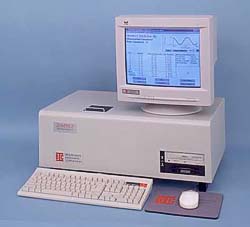
Brookhaven Instruments Zeta Potential and Particle Size Analyzer:
Zeta potential is a function of the surface charge of particles, any adsorbed layer at the interface, and the nature and composition of the surrounding medium in which the particles are suspended. It is usually of the same sign as the potential actually at the particle surface but, unlike the surface potential, the zeta potential is readily measured by experiment. Because it reflects the effective charge on the particles and is therefore related to the electrostatic repulsion between them, zeta potential is extremely relevant to the study and control of colloidal stability and flocculation processes.
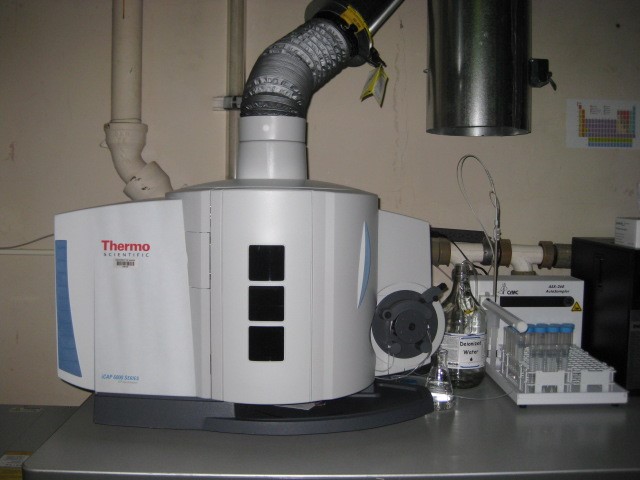
Thermo Scientific iCAP 6300 DUO:
An inductively coupled plasma optical emission spectrometer (ICP-OES) instrument for analyzing trace metals in various types of samples. It can detect about 70 different elements, including: Arsenic (As), Boron (B), Barium (Ba), Beryllium (Be), Cadmium (Cd), Cobalt (Co), Chromium (Cr), Copper (Cu), Iron (Fe), Manganese (Mn), Molybdenum (Mo), Nickel (Ni), Lead (Pb), Rhenium (Re), Antimony (Sb), Selenium (Se), Silicon (Si), Strontium (Sr), Uranium (U), Vanadium (V), and Zinc (Zn).
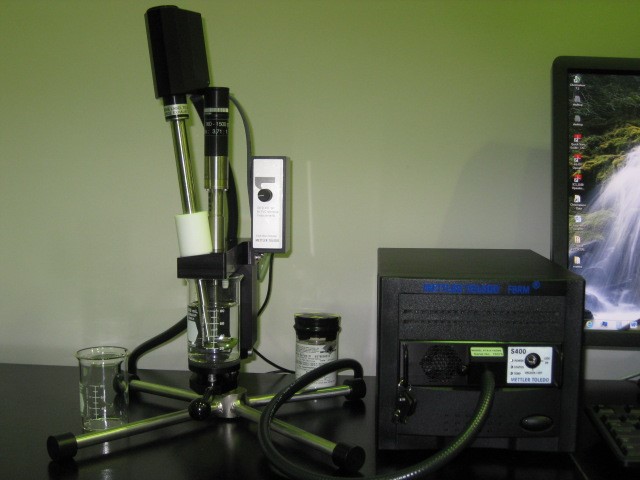
(Temporarily Unavailable) Mettler Toledo FBRM S400A:
A focused beam reflectance measurement instrument for determining the particle size distributions in waters and soil suspensions.
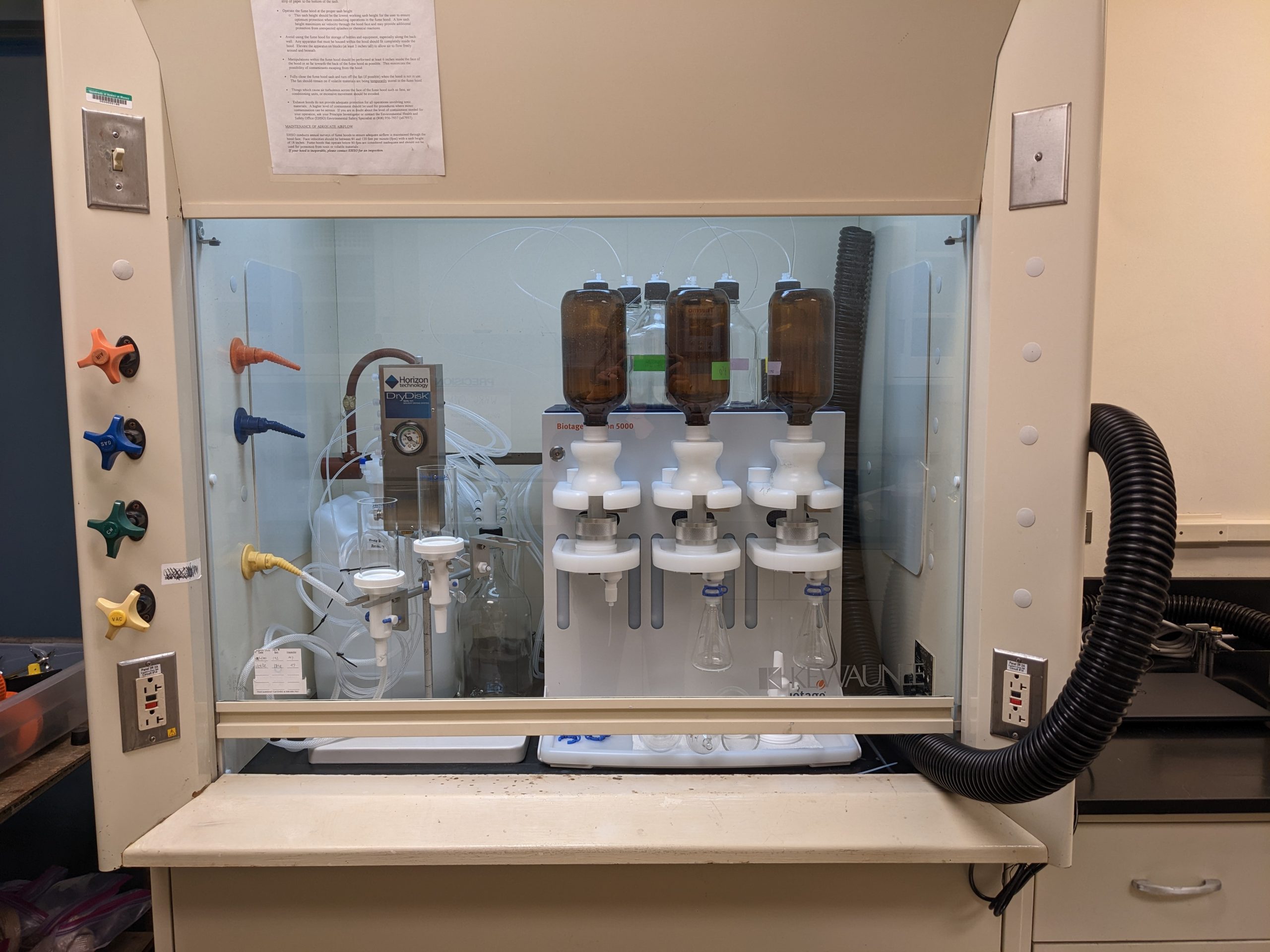
Biotage Horizon 5000:
The Biotage Horizon 5000 is a three-position automated disk extraction system that conditions the disk, loads the sample and elutes the analytes all without user intervention.
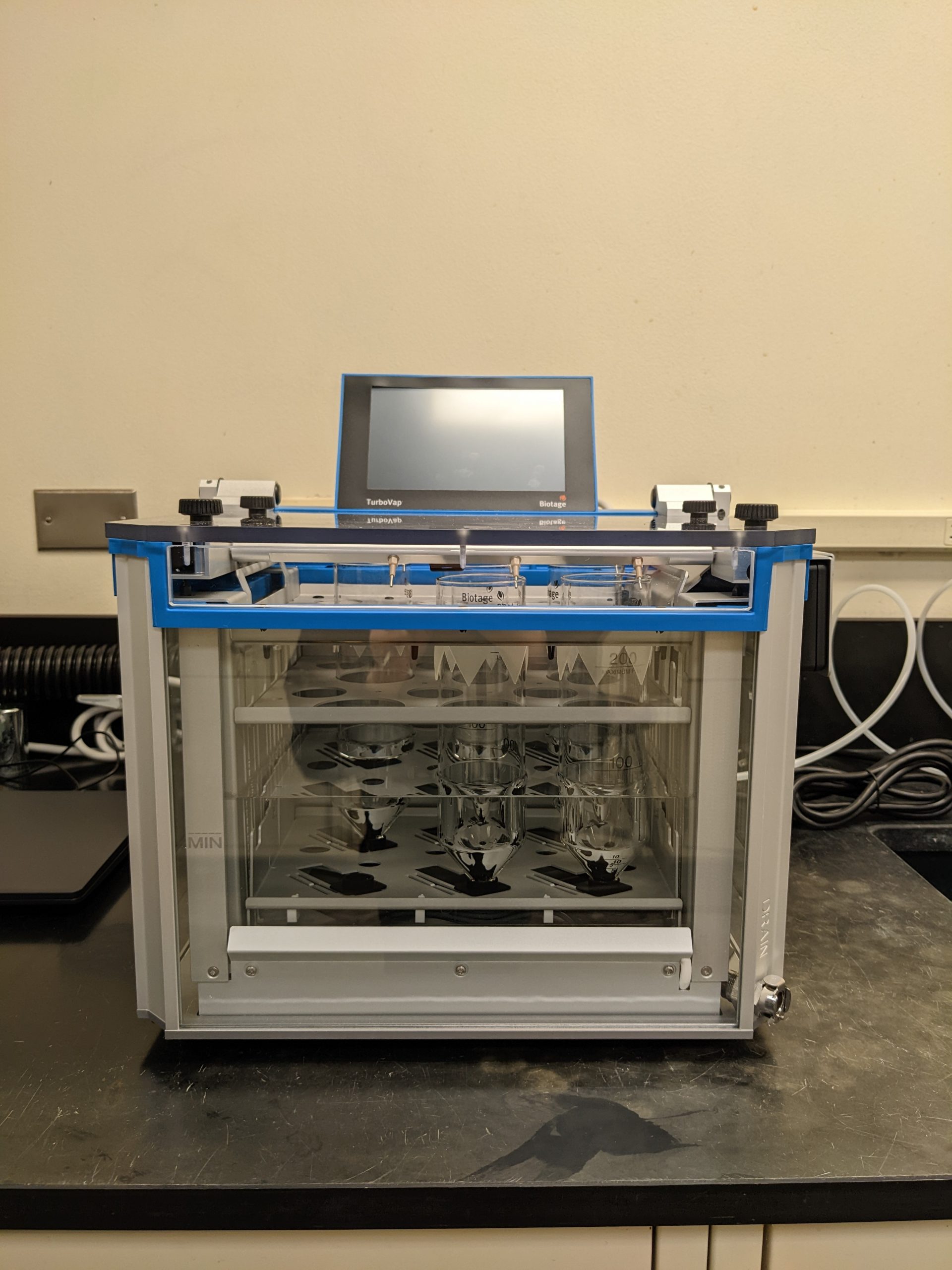
Biotage TurboVap II:
A solvent evaporation system which provides parallel evaporation of up to 6 samples with automatic end-point detection.
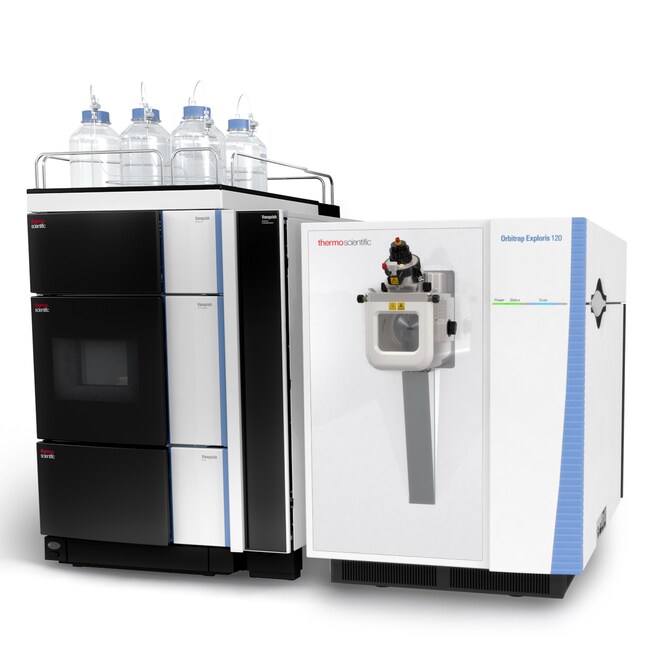
Thermo Scientific Vanquish Flex UHPLC and Orbitrap Exploris 240:
The Vanquish Flex Ultra High-Pressure Liquid Chromatograph (UHPLC) is a biocompatible system with a binary pump capable of operating up to 100 bar. This system is equipped with a Diode Array Detector (DAD) and a mass spectrometer. The DAD can be used for the analysis of ultraviolet absorbing compounds, typically compounds that contain unsaturated bonds or aromatic groups. The Orbitrap Exploris 240 mass spectrometer is a high-resolution mass spectrometer for targeted and untargeted analysis of LC-amenable organic compounds. The Easy-IC internal calibration ion source maintains mass accuracy while the high resolving power of up to 240,000 (FWHM) at m/z 200 allows for greater confidence in compound identification.